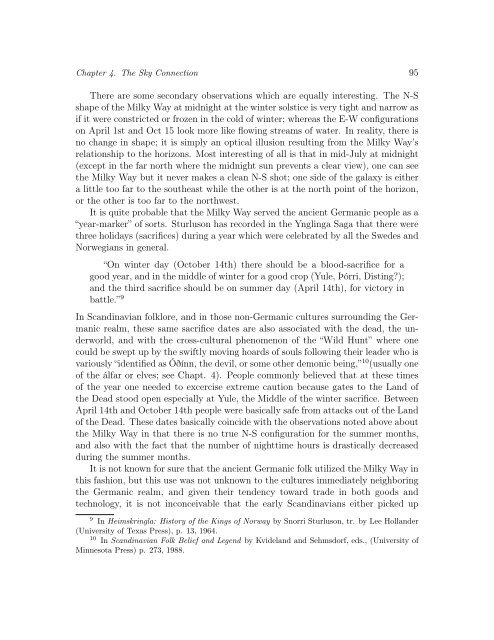Untitled - Awaken Video
Untitled - Awaken Video
Untitled - Awaken Video
Create successful ePaper yourself
Turn your PDF publications into a flip-book with our unique Google optimized e-Paper software.
Chapter 4. The Sky Connection 95<br />
There are some secondary observations which are equally interesting. The N-S<br />
shape of the Milky Way at midnight at the winter solstice is very tight and narrow as<br />
if it were constricted or frozen in the cold of winter; whereas the E-W configurations<br />
on April 1st and Oct 15 look more like flowing streams of water. In reality, there is<br />
no change in shape; it is simply an optical illusion resulting from the Milky Way’s<br />
relationship to the horizons. Most interesting of all is that in mid-July at midnight<br />
(except in the far north where the midnight sun prevents a clear view), one can see<br />
the Milky Way but it never makes a clean N-S shot; one side of the galaxy is either<br />
a little too far to the southeast while the other is at the north point of the horizon,<br />
or the other is too far to the northwest.<br />
It is quite probable that the Milky Way served the ancient Germanic people as a<br />
“year-marker” of sorts. Sturluson has recorded in the Ynglinga Saga that there were<br />
three holidays (sacrifices) during a year which were celebrated by all the Swedes and<br />
Norwegians in general.<br />
“On winter day (October 14th) there should be a blood-sacrifice for a<br />
good year, and in the middle of winter for a good crop (Yule, Þórri, Disting?);<br />
and the third sacrifice should be on summer day (April 14th), for victory in<br />
battle.” 9<br />
In Scandinavian folklore, and in those non-Germanic cultures surrounding the Germanic<br />
realm, these same sacrifice dates are also associated with the dead, the underworld,<br />
and with the cross-cultural phenomenon of the “Wild Hunt” where one<br />
could be swept up by the swiftly moving hoards of souls following their leader who is<br />
variously “identified as Óðínn, the devil, or some other demonic being,” 10 (usually one<br />
of the álfar or elves; see Chapt. 4). People commonly believed that at these times<br />
of the year one needed to excercise extreme caution because gates to the Land of<br />
the Dead stood open especially at Yule, the Middle of the winter sacrifice. Between<br />
April 14th and October 14th people were basically safe from attacks out of the Land<br />
of the Dead. These dates basically coincide with the observations noted above about<br />
the Milky Way in that there is no true N-S configuration for the summer months,<br />
and also with the fact that the number of nighttime hours is drastically decreased<br />
during the summer months.<br />
It is not known for sure that the ancient Germanic folk utilized the Milky Way in<br />
this fashion, but this use was not unknown to the cultures immediately neighboring<br />
the Germanic realm, and given their tendency toward trade in both goods and<br />
technology, it is not inconceivable that the early Scandinavians either picked up<br />
9 In Heimskringla: History of the Kings of Norway by Snorri Sturluson, tr. by Lee Hollander<br />
(University of Texas Press), p. 13, 1964.<br />
10 In Scandinavian Folk Belief and Legend by Kvideland and Sehmsdorf, eds., (University of<br />
Minnesota Press) p. 273, 1988.
















